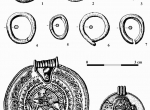Wapno
Wapno, Wągrowiec district, Greater Poland Voivodeship, site of discovery in 1850 of several gold objects (fig. 1.); they surfaced during the levelling of stone mounds associated with a Pomeranian Culture barrow cemetery found about 150 m to the west of the village. The type of deposit and its circumstances of discovery have been a subject of controversy. Recently it has been accepted that the objects belong to at least three separate deposits, inserted into the stone mounds, nos. 1 and 2 in the same tumulus, no. 3 in a different one. Hoard 1, deposited in a face urn, included a small gold vessel, three gold bracteats →Scandinavian Bracteat: one large, type C of O. Montelius, with a stylized image of a horseman and a human face, under a movable suspension loop, one small, type C of O. Montelius, with a suspension loop, a stylised image of a horseman and a runic inscription →Runes/ runic alphabet SABAR, the third, a small type, lacking determination; a few gold chains of at least three links, made of oval-sectioned wire, and six links fashioned from polygonal-sectioned wire, a gold ring of D-shaped section. Hoard 2, deposited in an urn, included a gold →Scandinavian Bracteat, type C of O. Montelius, with a broken off (?) loop. Hoard 3 included a gold ring, glass (?) beads, a number of undetermined iron (?) objects. The deposits, dated to late 6th century (phase E of the →Migration Period ), presumably were brought in from south-western Scandinavia, very likely, Bornholm, Scania or Funen, and buried as part of some religious practice. Their presence in Great Poland is associated with the penetration of the southern Baltic coast during late Antiquity (second half of 5th – first half of 6th century) by Scandinavian groups. The finds from W. passed in 1850 to Königliches Museum in Berlin. Some of the objects went missing around 1874. The →Scandinavian Bracteat from hoard 2 passed to the Poznan Society of Friends of Learning during the second half of the 19th and was in keeping of the museum in Poznań (Muzeum Wielkopolskie). There it went missing. The fate of all the other objects is unclear. Analogies from Polish finds: →Karlino . Scandinavian analogies: Rynkebygård (Funen), Sandergaard (Bornholm), Gantofta (Scania).
HM
Literature: J. Żak, Brakteaty z Wapna (pow. Wągrówiec) na tle porównawczym, Przegląd Archeologiczny, vol. 9 (1953), p. 80-116; J. Żak, Studia nad kontaktami handlowymi społeczeństw zachodniosłowiańskich ze skandynawskimi od VI do VIII w. n.e., Wrocław 1962; M. Kara, Skandynawski skarb złotych przedmiotów z przełomu starożytności i średniowiecza w miejscowości Wapno, woj. pilskie, Przegląd Archeologiczny, vol. 42 (1994), p. 73-110.
-
 full resolution
full resolution
Fig. 1. Selected gold finds from Wapno, Wągrowiec district; 1. gold ring of D-shaped section, 2-7 chain links, 8 – large bracteat, type C of O. Montelius, 9 – small bracteat with a runic inscription SABAR, type C of O. Montelius (J. Żak 1962, with suppleme


